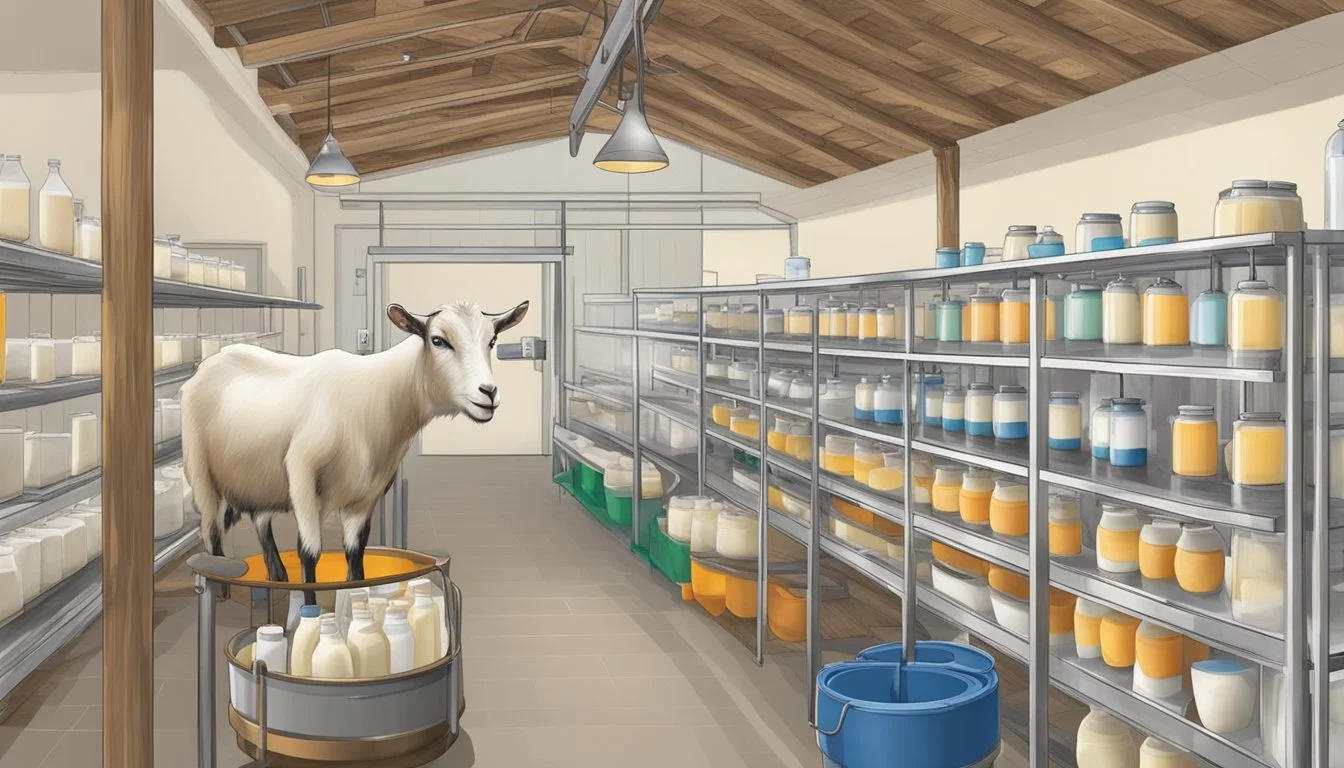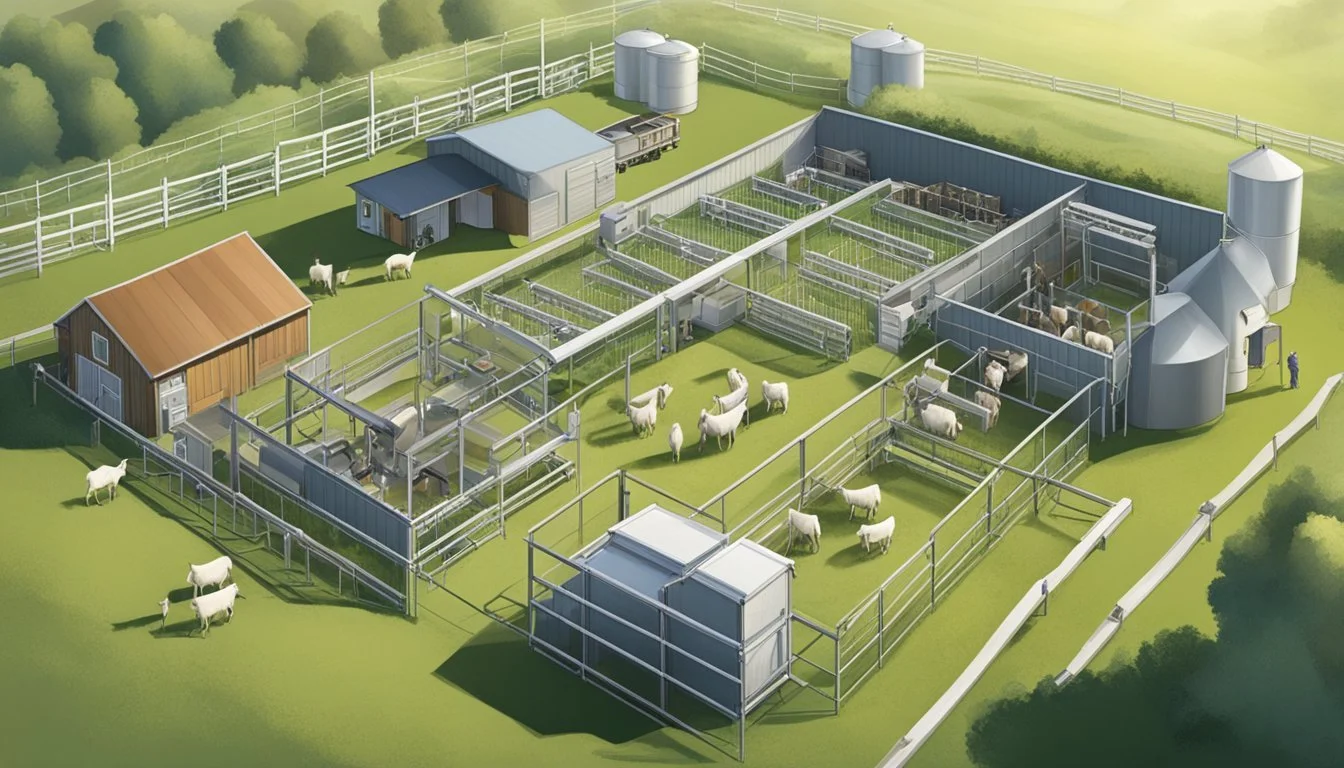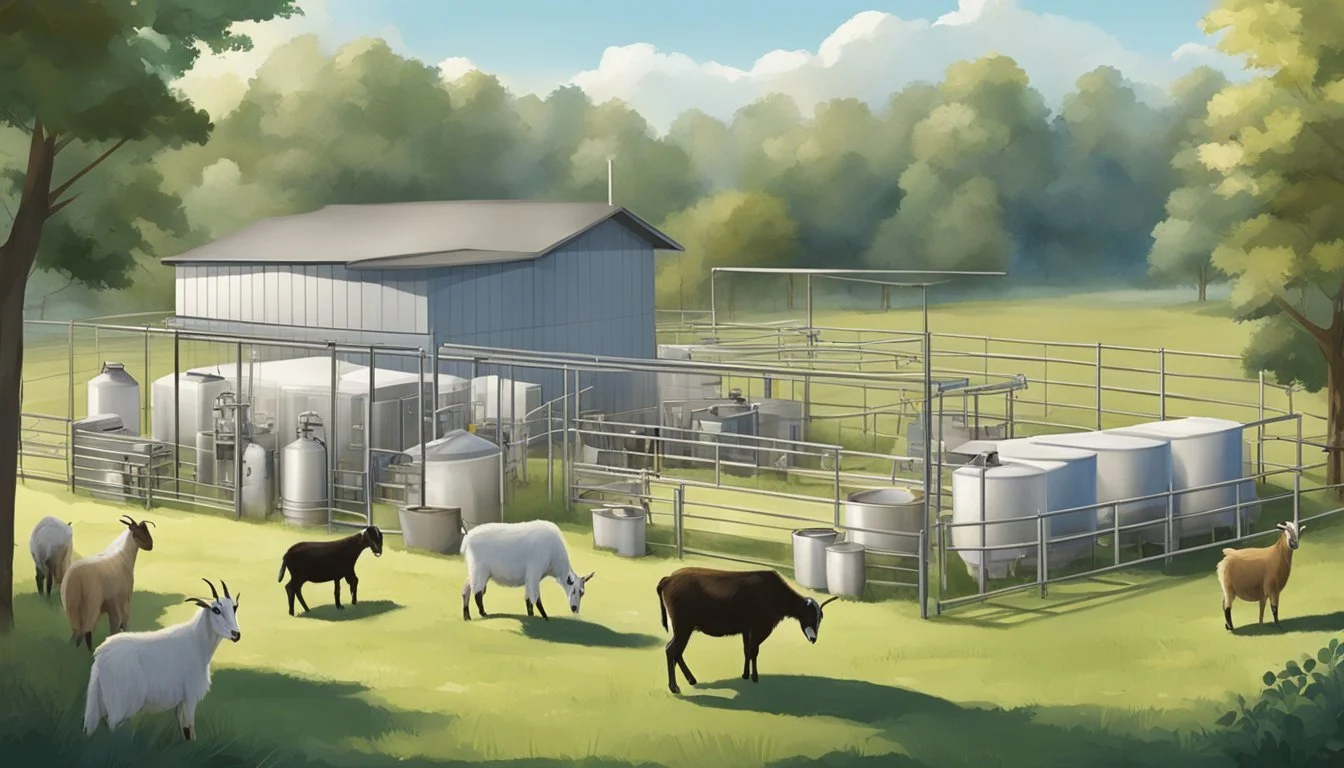How to Start a Small-Scale Goat Milk Dairy
Navigating Legalities and Implementing Best Practices
Starting a small-scale goat milk dairy can be an enriching endeavor for those interested in sustainable agriculture and artisanal food production. The journey begins with understanding the legal requirements and obtaining the necessary licensing, which is a vital step to ensure the safety and legality of the operation. Licenses can vary depending on the end product and the state regulations; for instance, many small goat dairies find that a grade B license may be more economical and is typically sufficient for many goat cheese processors.
In addition to legalities, best practices in goat farming are also key to success. Prospective dairy farmers must focus on choosing the right goat breed to meet their production goals, whether it be for milk, cheese, or yogurt. Effective management of the herd, from providing quality feed and water to ensuring a clean and safe living environment, is crucial for the health and productivity of the goats. Insights from successful small-scale operations indicate that adding value to goat milk through processed milk products, like cheese and yogurt, can open opportunities for retail distribution.
Understanding dairy licensing, food laws, and the practical aspects of goat husbandry allows a farmer to set a strong foundation for their dairy business. Whether aiming for local farmer's markets or larger scale distribution, these initial steps pave the way for a successful venture into the world of goat milk dairy farming.
Understanding the Goat Dairy Industry
The goat dairy industry in the United States represents a niche yet growing segment in agriculture. Characterized by small-scale operations, goat dairies cater to a burgeoning demand for goat milk products, including cheese, yogurt, and milk itself.
Goat milk is esteemed for its digestibility and unique flavor profile, a fact that is gaining recognition among consumers. The United States has seen a rise in goat milk products on the commercial market, with commercial processors showing interest in sourcing from small-scale farms. This increased interest is partly due to the versatility of goat milk and its products which are starting to etch a space within gourmet and health-conscious markets.
While the potential for profit exists, those interested in starting a goat dairy must navigate a series of legalities and regulations which can vary by state. These regulations ensure the quality and safety of milk products entering the market. Adherence to these legal matters is critical for the successful operation of a goat dairy farm.
Prospective goat farmers should also consider the following points:
Breeding and Husbandry: Goats require care and proper husbandry to produce quality milk.
Dairy Infrastructure: Milking stanchions and sanitary processing areas are essential.
Market Analysis: Investigating local market demands and potential sales venues is crucial.
Licensing: Obtaining the necessary dairy operation licenses is mandatory.
Collaboration with local agriculture extensions can be invaluable in getting started, as they provide resources and guided expertise. Engagement with local dairy goat clubs and associations can also offer support and firsthand insights into the industry.
With a methodical approach to understanding the goat dairy industry, small-scale dairy farmers can carve out a successful niche, providing quality goat milk products to an increasingly interested public.
Planning Your Goat Dairy
A successful small-scale goat milk dairy hinges on careful planning that aligns with your capacity, goals, and resources. It involves a synthesis of business strategy, animal husbandry, and an understanding of dairy production.
Assessing Your Goals and Scale
Before embarking on a goat dairy venture, it is crucial to determine the scale of the operation. Whether it's a part-time endeavor or a fully profitable business, outlining goals and assessing resources will set the foundation. Small-scale dairy can alleviate the pressure of commercial expectations, allowing a focus on high-quality, niche production.
Creating a Business Plan
Developing a business plan is non-negotiable. It should encompass all aspects of operations, from budgeting for initial investments such as livestock, equipment, and land, to ongoing costs like feed and veterinary care. Utilizing tools such as the Goat Farming Business Plan will aid in plotting a feasible roadmap to success.
Selecting the Right Breed
Choosing the appropriate breed is pivotal. High-yielding dairy goat breeds such as Nubian, Saanen, Alpine, Toggenburg, LaMancha, Oberhasli, and Sable vary in temperaments, milk production, and adaptability to climates. It's important to research each breed's characteristics to match them with your dairy goals.
Understanding Goat Nutrition and Health
Goat nutrition is a cornerstone of dairy success. Providing a diet rich in energy, protein, vitamins, and minerals is vital. High-quality forages like alfalfa and clover, along with supplemental grain, should be staples. Careful management of their diet supports the wellbeing of both pregnant and lactating goats, ensuring the production of high-quality milk.
Breeding and Reproduction
The cycle of a dairy depends on effective breeding and reproduction practices. Goats reach sexual maturity at different ages, and understanding the genetics behind your herd can enhance milk yield and quality. Breeds also dictate the frequency and timing of breeding. Monitoring the health of pregnant goats, caring for kid goats, and managing the lactation periods are all part of a successful reproduction protocol.
Farm Infrastructure and Equipment
To establish a small-scale goat milk dairy, one must prioritize the development of robust farm infrastructure and acquire the necessary equipment. Strategically designing robust shelters and creating sturdy fencing systems are fundamental for protecting livestock. Additionally, setting up efficient milking facilities and securing reliable equipment will streamline the dairy process.
Designing Appropriate Shelter and Fencing
Goats require dry and draft-free housing to protect them from weather extremes. A well-designed goat shelter should offer ample space for the goats to rest and move around, typically providing about 15-20 square feet per adult goat. Ventilation is key to prevent moisture build-up and ensure a healthy living environment. Shelter designs vary from simple three-sided structures to more complex barn layouts, based on labor constraints and resources available.
When it comes to fencing, sturdy and secure fencing is non-negotiable to keep goats safe and contained. Fencing options include woven wire, electric, or a combination of both, with heights generally ranging from 4 to 5 feet to prevent escape. The foundation for good fencing involves setting up strong corner posts and using appropriate materials that withstand the frequent pressure from goats leaning or climbing.
Milking Facilities and Equipment
A small-scale goat dairy needs a dedicated milking parlor or area that adheres to cleanliness standards to ensure the quality of milk. This milking facility should be designed for easy cleaning and maintenance, with non-porous surfaces and sufficient lighting. It's beneficial to have a milking stanchion to streamline the process, which can be a commercial system or a sturdy homemade stand, tailored to the farm's scale.
Milking equipment should include stainless steel buckets or an automated milking system, depending on budget and number of goats. It’s essential to ensure that all equipment, such as milk containers, hoses, and teat cups, are easily sanitized. Incorporating both proper washing sinks and storage for clean equipment will help maintain the necessary hygiene standards in milk production.
Managing the Dairy Operation
Effective management of a small-scale goat milk dairy involves meticulous attention to feeding systems, milking procedures, and the overarching health and welfare of the goats. These elements are crucial for ensuring high-quality milk production, efficient use of time and labor, and maintaining the health of the livestock.
Developing Efficient Feeding Systems
Feeding systems must provide adequate nutrition to the goats while optimizing the use of available pasture. It's essential to balance pasture time with supplemental feeding to maintain both animal health and milk quality. To do this, one can implement a rotational grazing system to manage pasture regeneration and prevent overgrazing. Moreover, proper storage and handling of feed will minimize waste. Detailed records of feed types and amounts help in fine-tuning the system for cost-efficiency.
Example of a simple feed management table:
Time of Year: Spring
Pasture Availability: High
Supplemental Feed Type: Mineral supplements
Quantity per Goat: 0.2 lbs/day
Time of Year: Summer
Pasture Availability: Moderate
Supplemental Feed Type: Hay, grains
Quantity per Goat: 0.5 lbs/day
Time of Year: Fall
Pasture Availability: Low
Supplemental Feed Type: Silage, hay
Quantity per Goat: 1.0 lbs/day
Time of Year: Winter
Pasture Availability: None
Supplemental Feed Type: Hay, grains
Quantity per Goat: 1.5 lbs/day
Milking Procedures and Milk Handling
Efficient and hygienic milking procedures are imperative. Goats should be milked at consistent times each day to regulate milk production and maintain quality. Before milking, one must clean the udders to prevent mastitis, a detrimental infection. The milk must be cooled rapidly after milking to reduce bacterial growth. It is critical to handle and transport milk in sanitized containers to ensure safety and quality for consumers.
Key steps in milk handling:
Sanitize all equipment before use.
Milk each goat thoroughly.
Strain milk to remove any impurities.
Cool down to 4°C (39.2°F) within an hour of milking.
Store in clean, chilled containers for transportation.
Animal Health and Welfare
A successful dairy operation prioritizes the health and welfare of its goats. Regular veterinary check-ups, vaccinations, and parasite control measures help to prevent disease and enhance productivity. Waste management is vital in controlling disease; a regularly cleaned barn and properly managed manure can significantly decrease the risk of infection. Additionally, providing shelter and care to protect the goats from harsh weather conditions and predators contributes to their well-being and, as a result, the quality of the goat's milk they produce.
Health checklist for dairy goats:
Vaccinations up-to-date
Deworming schedule
Daily health observation
Clean and dry living conditions
Adequate space for exercise and rest
By implementing these best practices in feeding, milking, and animal care, dairy goat farmers can ensure their operation runs smoothly, yielding high-quality milk in a sustainable and animal-friendly manner.
Legalities and Regulations
When embarking on starting a small-scale goat milk dairy, it's critical to navigate through the myriad of regulations and requirements that govern dairy operations. These rules are in place to ensure the safety and quality of milk products, as well as to facilitate fair market practices.
Understanding Dairy Regulations
The process begins by consulting the Department of Agriculture at both federal and state levels since each state may have unique mandates. For example, the Pasteurized Milk Ordinance (PMO) is a regulatory guideline provided by the Food and Drug Administration (FDA), which outlines standards for Grade A milk production. Compliance with these rules is essential for anyone looking to venture into dairy goat production. These regulations dictate aspects such as animal health, milking procedures, and milk handling. Moreover, educational resources from ATTRA and Langston University might offer invaluable insights into the regulatory landscape. They can help newcomers understand everything from zoning laws to environmental regulations that an alternative livestock enterprise must adhere to.
Processing and Selling Goat Milk
Once the dairy operation is compliant with basic health and safety regulations, attention must be turned to the specifics of processing and selling goat milk. This stage often requires obtaining additional licensing for processing facilities and ensuring that all equipment is approved for use. The marketing and sales strategy for the dairy must also be aligned with state requirements, focusing on labeling and advertising that are truthful and compliant. Producers may be required to work with inspectors to certify that their products are safe for consumption. Furthermore, for dairy operations aspiring to engage in interstate commerce or appeal to a broader market, adherence to federal regulations becomes paramount.
Following these guidelines will lay a solid foundation for operating a small-scale goat dairy within the bounds of the law, focusing on regulations and compliance as the cornerstones of a successful and sustainable enterprise.
Marketing Your Goat Milk Products
When entering the goat milk market, highlighting the unique taste and nutritional benefits of your products can set them apart. Farmers should consider various sales channels to reach their target audience effectively.
Direct Sales: Selling products directly from the farm can foster customer relationships and trust. For example, farmers can market their milk as a key ingredient for artisanal cheeses, emphasizing its unique flavor profile.
Online Marketing: Utilize social media and an engaging website to expand reach. Sharing content that educates about the unique taste and health benefits of goat milk can attract more customers.
Distribution: Building relationships with local commercial processors and retailers can lead to consistent sales volumes. They benefit from offering a local, high-quality goat milk source to their customers.
Pricing Strategy: Producers must set a price that reflects the quality and covers production costs to ensure sustainable profit.
Promotion: Engaging in community events, farmers' markets, and food festivals allows producers to showcase their products and directly interact with consumers. Sampling campaigns can help people appreciate the uniqueness of goat milk.
Legalities: Compliance with dairy licensing and food laws is critical for commercial sales. Familiarize oneself with the requirements to avoid legal hurdles.
Effective marketing of goat milk products requires strategic planning and a clear understanding of the target market's needs. Increased demand for healthy, locally-sourced dairy products can lead to lucrative opportunities for small-scale dairy goat farmers.
Expanding Your Business
When a small-scale goat milk dairy is ready to grow, the considerations of scaling up and diversification become critical factors that can determine long-term success and profitability.
Scaling Up and Diversification
Scaling up the production involves both increasing the herd size and enhancing the infrastructure on the farm. For a goat milk dairy, this could mean investing in more milking stations or larger cooling facilities to manage a greater volume of goat milk. Expanding the dairy's capacity must be accompanied by ensuring demand; this could involve establishing partnerships with commercial processors or expanding the consumer base for on-farm sales.
In diversifying, a dairy might begin breeding meat goats in addition to milking breeds. This can provide an additional revenue stream, especially if there's a market for veal or kid goat crop. However, diversification should not overshadow the dairy's primary product; maintaining quality goat milk production is essential.
Moreover, the dairy may also consider producing an on-farm substitute for products typically purchased. This could range from growing feed on-site to developing value-added products like cheese or yogurt. Both scaling and diversification require careful planning, market research, and a solid understanding of the dairy's operational capabilities and limitations.
Common Challenges and Solutions
Starting a small-scale goat milk dairy involves navigating various challenges, but effective solutions can ensure success.
Regulatory Compliance: One primary hurdle is meeting the legal requirements for selling dairy products.
Solution: Research and comply with local laws regarding goat milk production, including licensing and milk pasteurization standards.
Feeding and Management: Proper nutrition is essential for high milk yield and quality during the lactation period.
Solution: Implement a balanced diet plan and regular veterinary care to maintain herd health.
Breeding: Strategic breeding is crucial to ensure a continuous lactation period and steady milk supply.
Solution: Utilize professional breeding services or consider artificial insemination for genetic diversity and improved production.
Milk Handling and Storage: Preserving milk quality from contamination is challenging.
Solution: Establish clean milking practices and invest in proper storage facilities to keep the milk at the correct temperature.
Marketing: Finding a market for goat milk and products can be tough.
Solution: Develop a strong branding strategy and explore various market avenues such as farmers' markets, local stores, and dairy cooperatives.
Product Diversification: Relying solely on fluid milk may limit potential revenue.
Solution: Diversify into value-added products like cheese, yogurt, and ice cream, which can boost profitability.
Each challenge in a small-scale goat production venture is surmountable with informed strategies and consistent effort.
Case Studies and Success Stories
In the realm of small-scale goat milk dairies, many entrepreneurs have seen substantial success by adhering to stringent best practices and navigating the complex legalities of dairy production. For instance, a family-run dairy has made a name for itself producing high-quality feta goat cheese. Testament to their success is a meticulous business plan and a deep understanding of their target market.
Another narrative of achievement comes from smallholder farmers in Kenya and Tanzania, where a study has chronicled improved dairy goat management practices leading to enhanced growth and lactation performances. Factors contributing to their triumph include breed selection and upgrading strategies.
Key Factors for Success:
Legal Compliance: Secure necessary permits and meet health standards.
Quality Control: Implement regular health checks and quality assurance processes.
Market Research: Understand the consumer base and market demand for goat milk products.
By focusing on these key areas, small dairy businesses pave their path toward a sustainable and profitable model illustrated by these real-world examples. The stories emphasized here seal the idea that, with the right approach combined with resilience, small-scale dairy farmers can transform their operations into successful ventures.






